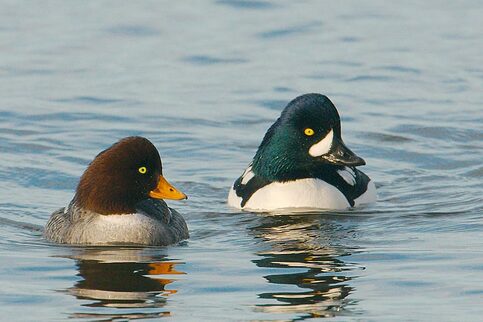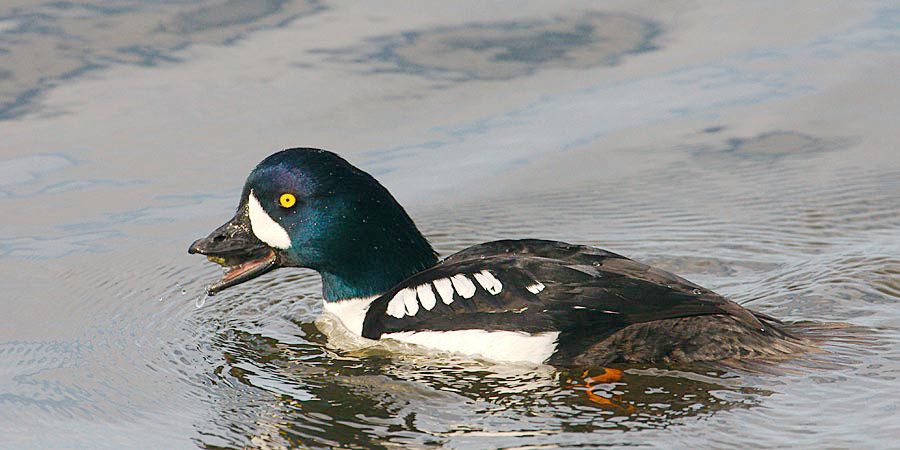Barrow's goldeneye • Bucephala islandica • Nuxalk - sk'ilcts (goldeneye)
{islandica = this species was originally described from a population in Iceland}
Barrow's goldeneye male (iridescent purplish head) and female (chocolate brown head). Photos by Mike Yip.
Identification
True to its name, this diving duck has distinctively bright golden eyes (paler in females) that contrast with dark richly-coloured heads: iridescent purplish-black head in the male, and chocolate brown in the female. The male can also be identified by the bright white, crescent-shaped patch on both sides of its face between its bill and eye, and the contrasting black and white on its body and wings. The female's body and wings are grey above and white below. The medium-sized duck's chunky appearance and large rounded head may aid identification, especially from a distance.
Habitat & Range
The Barrow's goldeneye can be found on the Central Coast in winter, in sheltered coastal waters such as bays and estuaries. The species can also be found on inland lakes and rivers where they don't freeze over. This species is mostly found in northwestern North America, with a winter range stretching along the coast from Alaska to northern California, and inland into areas of the northwestern United States. It migrates inland to breed on cold lakes and rivers, mostly in forested regions. There are also small populations in northeastern North America and Iceland.
Similar Species
Both the female and male of this species may be easily confused with their common goldeneye (Bucephala clangula) counterparts. For the female, check out the bill colour if you're unsure: the common goldeneye's bill is usually all dark grey or dark with a yellow tip (rarely all dull yellow), compared to the fully yellow-orange bill of the Barrow's. For the male, check the shape of the white face patches: those of the Barrow's are crescent-shaped, while the common goldeneye's are oval-shaped. The head shapes are also a bit different; the common goldeneye has more of a forehead slope than the Barrow's. As per its name, the common goldeneye is more common than the Barrow's. More information on differentiating these species can be found on the Cornell Lab of Ornithology's species profile.
iNaturalist
https://www.inaturalist.org/taxa/6994-Bucephala-islandica
True to its name, this diving duck has distinctively bright golden eyes (paler in females) that contrast with dark richly-coloured heads: iridescent purplish-black head in the male, and chocolate brown in the female. The male can also be identified by the bright white, crescent-shaped patch on both sides of its face between its bill and eye, and the contrasting black and white on its body and wings. The female's body and wings are grey above and white below. The medium-sized duck's chunky appearance and large rounded head may aid identification, especially from a distance.
Habitat & Range
The Barrow's goldeneye can be found on the Central Coast in winter, in sheltered coastal waters such as bays and estuaries. The species can also be found on inland lakes and rivers where they don't freeze over. This species is mostly found in northwestern North America, with a winter range stretching along the coast from Alaska to northern California, and inland into areas of the northwestern United States. It migrates inland to breed on cold lakes and rivers, mostly in forested regions. There are also small populations in northeastern North America and Iceland.
Similar Species
Both the female and male of this species may be easily confused with their common goldeneye (Bucephala clangula) counterparts. For the female, check out the bill colour if you're unsure: the common goldeneye's bill is usually all dark grey or dark with a yellow tip (rarely all dull yellow), compared to the fully yellow-orange bill of the Barrow's. For the male, check the shape of the white face patches: those of the Barrow's are crescent-shaped, while the common goldeneye's are oval-shaped. The head shapes are also a bit different; the common goldeneye has more of a forehead slope than the Barrow's. As per its name, the common goldeneye is more common than the Barrow's. More information on differentiating these species can be found on the Cornell Lab of Ornithology's species profile.
iNaturalist
https://www.inaturalist.org/taxa/6994-Bucephala-islandica
References
Barrow's goldeneye (Bucephala islandica). Audubon Guide to North American Birds. Accessed 19/04/2018.
Barrow's goldeneye (Bucephala islandica). The Birds of North America Online (A. Poole, Ed.). Ithaca: Cornell Lab of Ornithology. Retrieved from the Birds of North America Online. Accessed 19/04/2018.
Dunn, J. L. and Alderfer, J. (Eds.). (2011). National Geographic Field Guide to the Birds of North America. (6th Ed.). Washington, D.C.: National Geographic Society. Pp. 44-45.
Eadie, J. M., J. L. Savard, and M. L. Mallory (2000). Barrow's Goldeneye (Bucephala islandica), version 2.0. In The Birds of North America (A. F. Poole and F. B. Gill, Editors). Cornell Lab of Ornithology, Ithaca, NY, USA.
Authors and editors of page
Kelly Fretwell (2019)
Barrow's goldeneye (Bucephala islandica). Audubon Guide to North American Birds. Accessed 19/04/2018.
Barrow's goldeneye (Bucephala islandica). The Birds of North America Online (A. Poole, Ed.). Ithaca: Cornell Lab of Ornithology. Retrieved from the Birds of North America Online. Accessed 19/04/2018.
Dunn, J. L. and Alderfer, J. (Eds.). (2011). National Geographic Field Guide to the Birds of North America. (6th Ed.). Washington, D.C.: National Geographic Society. Pp. 44-45.
Eadie, J. M., J. L. Savard, and M. L. Mallory (2000). Barrow's Goldeneye (Bucephala islandica), version 2.0. In The Birds of North America (A. F. Poole and F. B. Gill, Editors). Cornell Lab of Ornithology, Ithaca, NY, USA.
Authors and editors of page
Kelly Fretwell (2019)






